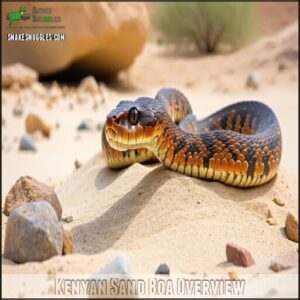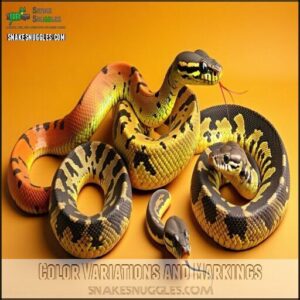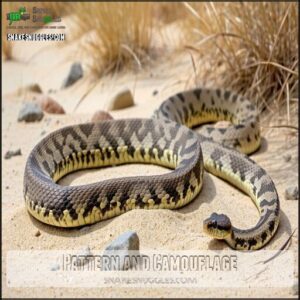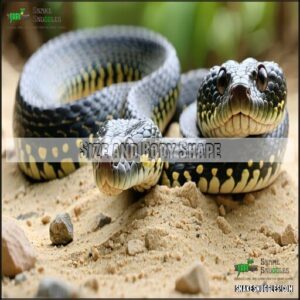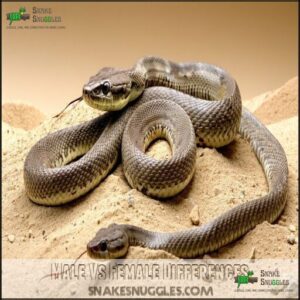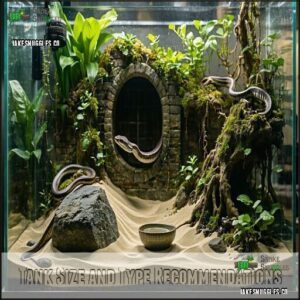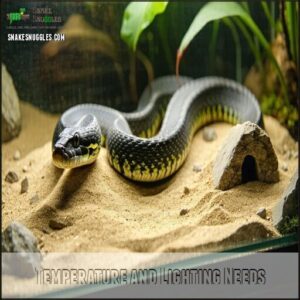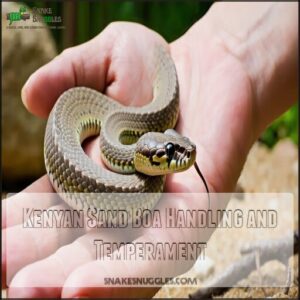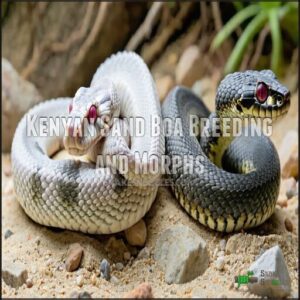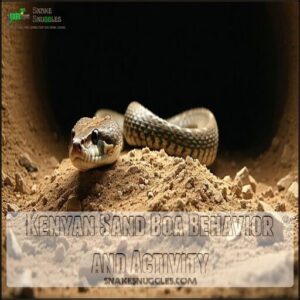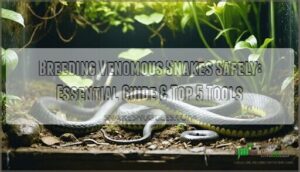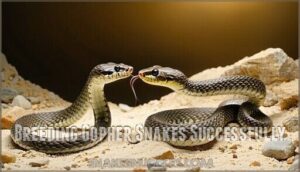This site is supported by our readers. We may earn a commission, at no cost to you, if you purchase through links.
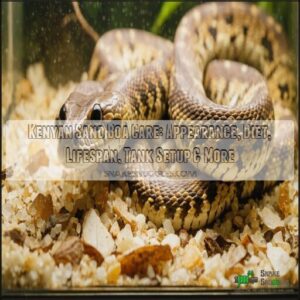 The Kenyan sand boa (Eryx colubrinus) is a small, burrowing snake from East Africa, known for its calm nature and adorable, “chunky” body.
The Kenyan sand boa (Eryx colubrinus) is a small, burrowing snake from East Africa, known for its calm nature and adorable, “chunky” body.
Adults usually reach 2-3 feet, with females being larger than males. Their sandy orange bodies, marked with brown blotches, help them blend into desert habitats.
They’re simple to care for—just set them up in a 10-20 gallon tank with aspen bedding for burrowing, keep temperatures around 90°F on one side, and feed frozen-thawed mice. These boas aren’t climbers and prefer hiding, so you’ll rarely see them out and about.
Ready to dig deeper into their quirky habits? Let’s go! They are also known for being easy to manage, with a straightforward care routine that includes providing the right environment and frozen-thawed mice.
Table Of Contents
- Key Takeaways
- Kenyan Sand Boa Overview
- Kenyan Sand Boa Appearance
- Kenyan Sand Boa Enclosure Setup
- Kenyan Sand Boa Diet and Feeding
- Kenyan Sand Boa Health and Husbandry
- Kenyan Sand Boa Handling and Temperament
- Kenyan Sand Boa Breeding and Morphs
- Kenyan Sand Boa Lifespan and Longevity
- Kenyan Sand Boa Behavior and Activity
- Kenyan Sand Boa Care and Maintenance
- Frequently Asked Questions (FAQs)
- Is a Kenyan sand boa a good pet?
- How big do Kenyan sand boas get?
- Do Kenyan sand boas like being handled?
- Is a Kenyan sand boa poisonous?
- How do Kenyan Sand Boas interact with other pets?
- Are Kenyan Sand Boas prone to escaping enclosures?
- What enrichment activities can I provide Kenyan Sand Boas?
- Can Kenyan Sand Boas thrive in bioactive setups?
- Are Kenyan Sand Boas suitable for children to handle?
- Can Kenyan Sand Boas coexist with other reptiles?
- Conclusion
Key Takeaways
- Kenyan sand boas are low-maintenance pets that thrive in a 10-20 gallon tank with aspen bedding, temperatures around 90°F, and a diet of frozen-thawed mice.
- They’re compact, calm, and burrowers by nature, making them great for beginner snake enthusiasts who want a manageable reptile.
- These boas prefer solitary living and require secure enclosures to prevent escapes, as they’re excellent at finding gaps.
- Regular handling strengthens trust, but approach gently and avoid sudden movements to ensure a stress-free interaction.
Kenyan Sand Boa Overview
The Kenyan sand boa (Eryx colubrinus) is a small, stout-bodied snake native to the sandy deserts and scrublands of East Africa.
Known for its burrowing behavior and calm temperament, this species makes a fascinating and manageable pet for reptile enthusiasts, particularly due to its calm temperament.
Native Habitat and Distribution
The Kenyan sand boa (Eryx colubrinus) thrives across its African origins, including East Africa and parts of the Middle East.
Its geographic range spans Egypt to Tanzania, favoring desert climates with loose, sandy soil.
This sand boa habitat shows impressive desert adaptation, allowing survival in harsh conditions.
However, habitat variation and conservation status concerns highlight the need for protecting this unique species.
Species Description and Classification
The Kenyan sand boa (Eryx colubrinus), part of the Boidae family, is a fascinating species with evolutionary adaptations for sandy habitats in East Africa.
Here’s why it stands out:
- Taxonomic History: It’s long-debated as a subspecies (colubrinus loveridgei).
- Physical Distinctions: Stout bodies, high-placed eyes, and blunt tails.
- Morph Genetics: Diverse colors, from albinos to unique stripes.
Docile Nature and Temperament
Kenyan sand boas are a docile snake, perfect for beginners.
Their gentle temperament makes handling easy, but they might bite if startled or mistaking fingers for food. Always approach calmly and support their body fully.
This beginner-friendly species thrives on routine handling, reducing bite risks while building trust.
| Behavior | Challenge | Solution |
|---|---|---|
| Shy temperament | Stress during handling | Lift gently from underneath |
| Mistakes hand for food | Bite risk while feeding | Use feeding tools |
| Sedentary lifestyle | Lack of movement in enclosure | Provide enrichment via hides |
Unique Characteristics and Features
Burrowing snakes like the Kenyan sand boa have some remarkable traits.
Their sand-swimming skills come from their stout bodies and camouflage in yellow, brown, or orange hues.
With eyes and nostrils placed perfectly for life underground, they avoid sand while staying aware.
Add a blunt tail serving as defense and sexual dimorphism enhancing reproduction, and you’ve got a truly fascinating species!
Kenyan Sand Boa Appearance
Kenyan sand boas (Eryx colubrinus) are small, stout snakes known for their smooth scales and vibrant patterns, ranging from orange and yellow to black and brown.
Their unique, rounded bodies and short tails make them easy to recognize, and their coloration helps them blend perfectly into sandy habitats.
Color Variations and Markings
If you’re captivated by the unique colors of Kenyan sand boas, their variety won’t disappoint.
From Albino morphs with soft hues to Anerythristic variations in grayscale, there’s a morph for everyone.
Kenyan boa morphs impress with their endless color inheritance, like:
- Bright orange with Striped patterns
- Pure Patternless forms
- Bold dark blotches on yellow
- Pinkish tones with subtle contrasts
Choose your favorite!
Pattern and Camouflage
Patterns on Kenyan Sand Boas aren’t just beautiful—they’re nature’s survival plan.
With blotches mimicking sandy terrain, their camouflage mechanisms make them nearly invisible.
These patterns serve four purposes:
- Blending In: Perfectly matches their habitat.
- Predator Avoidance: Confuses attackers.
- Hunting: Great for ambushing prey.
- Mimicking Direction: Head or tail? Predators can’t tell!
Beyond these wild-type patterns, breeders have developed Kenyan sand boa morphs with unique colorations.
Size and Body Shape
In terms of size and body shape, the Kenyan sand boa is a small snake with unique proportions.
Adults reach 12-36 inches, with sexual dimorphism evident—females grow larger than males, often exceeding two feet.
These girthy snakes feature a short, cylindrical body that’s thick and evenly proportioned.
Their smooth scales resemble polished beads, enhancing their sleek, burrowing abilities.
Full-grown boas have a wormlike appearance, perfect for gliding through sandy habitats.
Despite their compact size, they exhibit impressive strength and adaptability in their natural and captive settings.
Male Vs Female Differences
When sexing Kenyan Sand Boas, females noticeably outgrow males.
Females reach up to 3 feet long and weigh nearly 1 kg, while males typically max out at 2 feet, weighing around 100 grams.
Size differences aside, males have rounder, longer tails, aiding in breeding behavior, while females’ tails are shorter and stubbier.
Growth rates also vary, with females maturing slower, reflecting their role in reproduction.
Spot these tail shapes for quick identification!
Kenyan Sand Boa Enclosure Setup
Setting up the perfect enclosure for your Kenyan sand boa (Eryx colubrinus) guarantees it stays healthy and stress-free.
You’ll need to focus on proper tank size, substrate, temperature, and humidity to match their natural habitat, ensuring a stress-free environment for your Kenyan sand boa.
Tank Size and Type Recommendations
A Kenyan sand boa’s minimum enclosure size is a 30-gallon tank (36” x 18” x 18”).
Choose durable materials and make certain a secure setup.
Consider these options:
- Glass or acrylic terrariums for visibility.
- Front-opening enclosures for easy access.
- Secure lids for tank security and ventilation.
- Ample vertical space if housing multiple snakes safely.
Selecting the right boa tank supplies is vital for your pet’s well-being.
Create a cozy snake enclosure!
Substrate Requirements and Options
Choosing the right substrate keeps your Kenyan sand boa happy and healthy. Aim for a 3-4 inch substrate depth, balancing burrowing needs and maintenance.
Reptile sand mimics their natural habitat, while aspen shavings guarantee easy cleaning. Cypress mulch advantages include natural forest flooring and ideal humidity control.
Avoid potential issues like humidity impact by spot-cleaning daily.
| Substrate Option | Benefits | Drawbacks | Cleaning Frequency |
|---|---|---|---|
| Reptile Sand | Natural burrowing | Risk of impaction | Daily |
| Aspen Shavings | Soft, absorbent | Less natural for burrow | Daily |
Temperature and Lighting Needs
How do you keep your sand boa cozy? Start with a basking spot at 95°F using a UVB lamp or ceramic heat emitter.
Create a temperature gradient with 76-85°F for the warm zone and 72-80°F on the cool side. Heat mats help maintain steady warmth but pair them with a thermostat to avoid overheating.
Night temperatures should dip slightly to mimic nature’s chill but stay safe for your boa. Some owners utilize specific UVB products to guarantee proper health.
Forget fancy light shows; they just need functional, consistent lighting and warmth. Proper ventilation guarantees stable conditions, helping your Eryx colubrinus thrive while staying snug in their sandy burrowing hideout.
Humidity and Water Requirements
Humidity levels should stay between 50-60%, creating a desert-like environment that’s just right.
A small water dish works wonders for hydration and shedding aid. Mist the tank lightly about once a week, but don’t overdo it—this isn’t a rainforest! Use a humidity gauge for accuracy and try these tips: Maintaining the correct humidity control products is essential for their health.
- Place a humid hide with moss to maintain moisture.
- Refresh the water dish daily.
- Use Reptisafe for safe water.
Kenyan Sand Boa Diet and Feeding
Feeding your Kenyan sand boa (Eryx colubrinus) is straightforward, as they thrive on a diet of appropriately sized rodents like mice.
You’ll want to match prey size to the snake’s girth for safe, stress-free meals.
Food Options and Prey Items
Wondering what to feed your Kenyan sand boa? Their snake diet primarily includes frozen-thawed mice like pinkies or fuzzies.
Live feeding is another option but requires careful supervision. Verify the prey size matches your boa’s width for easy swallowing.
Nutritional supplements aren’t typically needed. Also, Reptilinks offer variety, mimicking a natural menu many reptile snakes enjoy.
Feeding Schedule and Frequency
Feeding your Kenyan sand boa on a proper schedule keeps it healthy and happy.
Balance frequency with their age and size:
- Hatchlings: Pinky mice every 5-7 days.
- Juveniles: Fuzzy mouse every 10-14 days.
- Adult males: Hopper mice every 2-4 weeks.
- Adult females: Small mice every 2-3 weeks.
Avoid overfeeding—common regurgitation causes include oversized prey or stress.
Supplementing their diet guarantees proper vitamin intake for peak health.
Feeding in The Enclosure Vs Outside
Feeding Kenyan sand boas in their enclosure reduces stress and behavioral impact but can create hygiene concerns.
Feeding outside helps with risk mitigation and snake safety, especially with frozen-thawed prey or feeder mice.
Use this table to choose the best method:
| Factor | In-Enclosure Feeding | Outside Enclosure Feeding |
|---|---|---|
| Stress Reduction | High | Medium |
| Hygiene Concerns | Moderate | Low |
| Snake Safety | High | High |
| Time Efficiency | High | Low |
| Behavioral Impact | Low | High |
Prey Size and Selection
After deciding where to feed your Kenyan sand boa, focus on prey size and type.
Choosing prey no wider than the thickest part of your snake guarantees smooth digestion and prevents choking.
Ideally, select prey about 1–1.5 times the snake’s head diameter.
Younger snakes thrive on pinky mice, while larger adults can handle rat pups.
Stick to frozen-thawed prey to avoid injuries—live prey can unexpectedly fight back.
Feeding weekly or biweekly meets their nutritional needs, depending on age and size.
Want variety?
Try rotating feeder mice and other appropriately sized rodents.
Pro tip: gut-loading prey boosts nutrients, supporting your snake’s health.
Kenyan Sand Boa Health and Husbandry
Keeping your Kenyan sand boa (Eryx colubrinus) healthy starts with understanding their unique care needs and spotting early signs of illness.
With proper husbandry and preventative measures, you’ll guarantee a long and stress-free life for your snake.
Common Health Issues and Symptoms
Kenyan Sand Boas can face health issues like respiratory infections, scale rot, mites, and mouth rot.
Watch for signs like lethargy, blister disease, regurgitation, or stuck shed. Obesity may occur from overfeeding.
Mites cause itching and irritation. A healthy boa stays hydrated, with smooth scales and regular appetite.
Seek a reptile-savvy vet for persistent symptoms, as a healthy boa is crucial for preventing issues like obesity.
Preventative Measures and Husbandry Tips
A clean habitat is key to Kenyan sand boa care.
Use sandy substrates for burrowing and shedding assistance.
Maintain substrate hygiene by removing waste promptly.
Quarantine newcomers to avoid parasite spread.
Verify hydration practices with fresh water, though they prefer dry conditions.
These small snakes thrive when their enclosure mimics natural habitats, combining good reptile husbandry with simple snake health routines, ensuring a clean habitat.
Quarantine and Isolation Procedures
When you bring home a new Kenyan sand boa (Eryx colubrinus), isolation is non-negotiable.
Start with an initial quarantine lasting 30-45 days in a separate enclosure. Watch for health concerns like mites, parasites, or unusual behavior, as these can signal disease.
Use separate equipment—don’t share tongs, water bowls, or hides with other reptiles to avoid spreading issues. Handling precautions are key; always wash your hands before and after.
If you notice anything alarming, consult a veterinarian promptly. Quarantine isn’t just a hassle—it’s your snake’s best defense against spreading illness to others. Think of it as their little health “spa retreat” to ensure their well-being and prevent the spread of disease, making quarantine a crucial step, and remember that handling precautions are essential for their health.
Signs of a Healthy Kenyan Sand Boa
Spot a healthy Kenyan sand boa with these signs:
- Energetic Behavior: Active burrowing and flicking its tongue regularly to explore.
- Clear Shedding Cycle: The snake sheds smoothly, leaving no torn pieces.
- Stable Weight: Consistent weight, a firm body, and a healthy appetite during snake feeding.
Bright, clear eyes and proper shedding mean your boa is thriving.
Kenyan Sand Boa Handling and Temperament
Handling your Kenyan sand boa (Eryx colubrinus) properly helps reduce stress and strengthens trust over time. These snakes are naturally shy but tolerate gentle, infrequent handling once they feel secure.
Handling Frequency and Duration
Building trust with your Kenyan sand boa means handling it gently and wisely.
Start with short, weekly sessions—around 10-15 minutes. Use beginner handling tips like supporting its body fully to reduce handling stress signs.
Pay attention to shedding as snakes may avoid contact during this time. Avoid sudden moves to mitigate bite risks and guarantee a smooth experience.
Stress and Anxiety Prevention
Minimizing stress for your Kenyan sand boa means thoughtful care. Stick to a consistent routine and provide secure hides within the enclosure. Maintain proper temperatures with enrichment like logs or plants.
When handling, use gentle techniques: lift confidently from underneath and avoid sudden movements. These simple steps help your boa feel safe and reduce stress factors like anxiety or bite risks.
- Provide hiding spots for comfort.
- Maintain consistent temperatures.
- Add enclosure enrichment like rocks or branches.
- Use calm, steady handling precautions.
Biting and Defensive Behavior
Kenyan sand boas rarely bite, but understanding their defensive postures helps reduce bite risks.
These snakes rely more on retreat than aggression, but mishandling can trigger defensive action.
To handle safely:
- Pick up from the middle, not tail or head.
- Use slow, deliberate movements.
- Avoid startling them during feeding times.
- Always approach from the side to minimize stress factors and handling risks.
Taming and Trusting Your Pet
How do you build trust with a Kenyan sand boa? Start small.
Let it recognize your scent before handling. Regular, gentle handling strengthens bonds and helps reduce stress.
Pay attention to signals—don’t rush a bite-prone moment.
Safe handling and consistency make them docile companions. With patience, they’ll see you as a friend, not a threat.
Kenyan Sand Boa Breeding and Morphs
Breeding Kenyan sand boas (Eryx colubrinus) is a fascinating process that requires careful attention to temperature cycling and habitat conditions.
With their diverse morphs like albino, anerythristic, and snow, these snakes offer exciting opportunities for creating unique color patterns, making them a great subject for breeding.
Breeding Basics and Requirements
Successful sand boa breeding starts with mimicking their natural mating season, including environmental shifts. During cooler months, gradually reduce tank temperatures to 70-75°F at night and increase feeding. Pair healthy males and females in a secure enclosure.
- Clutch Size: Expect 5-15 live births after 4-5 months.
- Incubation Methods: Guarantee proper hydration for pregnant females.
- Genetic Considerations: Breed responsibly to avoid hereditary issues.
Breeding Kenyan Sand Boas takes patience but offers rewarding results!
Morphs and Color Variations
Kenyan sand boas are like nature’s artwork, showcasing an impressive range of color variations.
Albino Morphs stand out with light hues of yellow, pink, and orange, while Anerythristic Types offer striking black-and-white patterns.
For unique flair, explore Striped Patterns or the soft tones of Snow Morphs, a blend of albino and axanthic genes.
Fancy something subtle? The Patternless Forms offer a clean, uniform look.
These morphs don’t just add variety—they highlight your boa’s individuality, making them a colorful gem for any snake enthusiast.
Breeding for Specific Traits and Characteristics
Breeding Kenyan Sand Boas for specific traits can be rewarding with patience and planning.
Using Selective Breeding effectively helps produce dazzling morphs while promoting genetic health.
Focus on key goals:
- Enhance Morph Selection for vibrant color variations and patterns.
- Prioritize Trait Heritability while maintaining healthy genetic diversity.
- Use proper Incubation Techniques to guarantee strong hatchlings.
- Balance visual appeal with ethical captivity breeding practices.
Create stunning, unique color morphs responsibly!
Albino Kenyan Sand Boas and Other Variants
Albino morphs captivate with their vibrant patterns, showcasing unique albino genetics.
Striped variations feature bold stripes, while Snow morphs blend white and soft yellows.
Albino morphs dazzle with their vibrant hues, a stunning showcase of genetics blending nature’s artistry with radiant beauty.
Patternless morphs stand out for their clean simplicity, and anerythristic traits replace reds with subtle grays.
Kenyan Sand Boa morphs express stunning color variety, offering enthusiasts a chance to appreciate nature’s artistry through careful, ethical breeding practices.
Kenyan Sand Boa Lifespan and Longevity
Kenyan sand boas (Eryx colubrinus) can live up to 20 years in captivity with proper care and diet, making them a long-term commitment.
Their lifespan depends on factors like genetics, environment, and consistent husbandry practices.
Average Lifespan and Expectations
With proper care, a Kenyan sand boa can live an average lifespan of 15-30 years in captivity.
Their health and aging typically remain steady, making them a long-term commitment.
Exceptional cases of record longevity do occur, though factors affecting this depend on consistent attention to health concerns.
Caring for these snakes guarantees they age gracefully, thriving as cherished companions.
Factors Affecting Longevity and Health
A Kenyan sand boa’s lifespan, often reaching 20 years, hinges on health and care.
Small tweaks make a big difference:
- Provide an escape-proof enclosure with environmental enrichment.
- Reduce stress by limiting heavy handling.
- Feed appropriately-sized prey to prevent health issues like obesity.
- Guarantee reliable hydration to ward off health concerns.
- Prevent nutritional deficiencies—keep their diet balanced.
Prioritize their comfort, and they’ll thrive!
Record Lifespan and Exceptional Cases
Some Kenyan sand boas set records, living over 30 years in captivity.
Exceptional individuals owe their maximum lifespan to ideal care and genetic influence.
By addressing common health issues and providing the right environment, you’re fostering longevity.
These snakes are primarily nocturnal, hunting at night and spending the day burrowed or basking.
While their lifespan surpasses wild expectations, this long-term commitment rewards you with a thriving, unique companion—a true tribute to dedication and care.
Health and Aging in Kenyan Sand Boas
As Kenyan sand boas age, watch for slower movements, duller scales, or shedding problems.
To keep yours healthy and thriving:
- Avoid obesity with a balanced feeding schedule.
- Watch for common ailments like scale rot or respiratory issues.
- Provide preventative care, like clean enclosures and proper humidity.
- Consult a vet for health issues or sensitive topics like euthanasia.
A healthy boa lives happily!
Kenyan Sand Boa Behavior and Activity
Kenyan sand boas (Eryx colubrinus) are known for their shy, burrowing nature, spending most of their time hidden beneath the substrate.
These snakes are generally inactive during the day but become more alert at night, relying on stealth to ambush their prey.
Natural Behavior and Instincts
The Kenyan sand boa thrives as a burrowing expert, using sandswimming to vanish beneath soil.
A true master of sandswimming, the Kenyan sand boa disappears beneath the soil with unmatched stealth and grace.
It’s a nocturnal ambush predator, waiting patiently to surprise prey.
With camouflage, it blends perfectly with its environment.
These snakes adopt a solitary nature, avoiding social interactions.
When threatened, their defensive mechanisms include retreating or hiding rather than fighting—an instinctive survival strategy over confrontation!
Activity Patterns and Schedule
As you observe your Kenyan sand boa’s natural behavior, you’ll notice they’re most active at night, exhibiting nocturnal behavior.
This adaptation allows them to thrive in their desert habitat, with activity peaking during dusk and dawn. Their daily routine shifts with seasonal changes, occasionally slowing for a brief hibernation period.
Be patient, as these sneaky snakes enjoy hiding beneath the sand! As you learn their patterns, you’ll discover their feeding activity is also influenced by their nocturnal nature.
Understanding their behavior will help you provide the best care for your pet Kenyan sand boa. Because they’re easy to handle, they make excellent pets for beginners.
Burrowing and Hiding Behavior
In regards to burrowing behavior, the Kenyan sand boa thrives in substrates with enough depth for total concealment.
This nocturnal hider adores digging into soft sand or aspen shavings for security. Providing burrowing benefits like stress reduction and hiding spots mimics their natural habitat, keeping them calm.
Deep substrate is essential for their instincts, creating an engaging setup they’ll love, which includes hiding spots.
Social Interaction and Pairing
Even though sand boas prefer being alone, you can still house pairs or small groups if their enclosure is spacious enough.
Always watch for cohabitation risks like aggression or stress. Introducing pairs gradually helps reduce tension, especially during the mating process.
Breeding compatibility matters, so separate the pair after mating to avoid injuries. Provide plenty of enrichment strategies like hides to ease competition.
A gravid female should always have her own space to stay comfortable, ensuring her well-being and reducing stress.
Kenyan Sand Boa Care and Maintenance
Keeping your Kenyan sand boa’s habitat clean and well-maintained guarantees its long-term health and comfort.
Regularly monitor temperature, humidity, and water conditions to create a stable environment that mimics its natural desert habitat, ensuring a stable environment.
Tank Maintenance and Cleaning
Maintaining your snake’s enclosure is straightforward and rewarding.
Replace the substrate monthly to prevent bacteria buildup. Clean the water dish weekly to guarantee water sanitation.
Remove waste and spot-clean daily to avoid odors and mold. Don’t forget to clean any hides and decor during deep cleans—it’s like housekeeping for your boa’s burrow!
A tidy tank means a happy snake.
Temperature and Lighting Maintenance
Keep your Kenyan sand boa cozy by ensuring proper temperature and lighting. Aim for a basking spot temp of 95°F with a halogen heat bulb. Maintain a gradient: 76-82°F on the cool side and 80-85°F on the warm side.
Use a thermostat to avoid overheating and promote heat regulation. Nighttime temperatures can safely dip to 72°F. Monitor consistently with a temperature gun.
UVB benefits aren’t mandatory but can enhance well-being.
- Halogen bulb
- Thermostat
- Heat mat (under-tank, with safety in mind)
- Ventilation
- Temperature monitoring tools
Humidity and Water Maintenance
Proper humidity and hydration are essential for your Kenyan sand boa’s well-being.
Aim for humidity levels around 50-60%, which support shedding and overall comfort.
A digital hygrometer helps you monitor this accurately—think of it as your snake’s wellness indicator.
Mist the enclosure lightly once a week to boost humidity; just don’t overdo it.
For water, use a small dish that minimizes spills but allows easy access.
Replace the water daily for high-quality, as stagnant water can cause issues.
Keep an eye on hydration signs like smooth shedding.
This simple routine makes certain your boa thrives with a balanced, stress-free environment, ensuring proper humidity and hydration.
Regular Check-Ups and Monitoring
You’ve got to stay sharp regarding your Kenyan sand boa’s health.
Regular weight monitoring, shedding observation, and fecal analysis can help spot issues early. Look for signs of respiratory health problems or changes in skin condition.
They’re subtle but key clues. If anything seems off, like appetite loss or inactivity, consult a reptile care veterinarian.
Staying proactive guarantees your snake pet stays happy, thriving, and free from disease. Prevention beats cure every time, and it’s crucial for maintaining your pet’s overall health.
Frequently Asked Questions (FAQs)
Is a Kenyan sand boa a good pet?
Having a Kenyan sand boa as a pet is like having a chill roommate.
Eryx colubrinus is docile, low-maintenance, and perfect for beginners.
They’re easy to handle, require modest setups, and rarely bite.
How big do Kenyan sand boas get?
Adult Kenyan sand boas, Eryx colubrinus, typically grow between 1-3 feet long.
Females usually reach larger sizes around 2-3 feet, while males stay smaller, averaging 1-2 feet.
Their compact size makes them manageable pets.
Do Kenyan sand boas like being handled?
Imagine a snake that’s part introvert.
Kenyan sand boas (Eryx colubrinus) tolerate handling, rarely bite, and stay calm if you’re gentle.
Support their girthy body, avoid sudden moves, and they’ll squirm through interactions just fine.
Is a Kenyan sand boa poisonous?
No, a Kenyan sand boa isn’t poisonous.
It’s a constrictor, meaning it squeezes its prey rather than using venom.
They’re harmless to humans and rely more on hiding than attacking in defense.
How do Kenyan Sand Boas interact with other pets?
They’re solitary and won’t bond with other pets.
While unlikely to harm small animals, interactions should be avoided to reduce stress or accidents.
Keep them in secure enclosures to prevent any curiosity-driven encounters.
Are Kenyan Sand Boas prone to escaping enclosures?
Yes, they can escape if the enclosure isn’t secure.
These sneaky snakes excel at finding gaps, so make sure lids lock tightly and check for spaces they might squeeze through.
Their persistence might surprise you!
What enrichment activities can I provide Kenyan Sand Boas?
Provide deep substrate for burrowing, hide boxes for exploring, and varied textures like smooth rocks or cork bark.
Rotate enclosure decor periodically.
Scatter food for hunting practice—it’s a simple way to keep them engaged!
Can Kenyan Sand Boas thrive in bioactive setups?
Kenyan Sand Boas (Eryx colubrinus) can adapt to bioactive setups, but it’s tricky.
They’re burrowers, so their constant digging can disrupt plants and microfauna.
Use hardy plants, deep substrate, and regular checks to maintain balance.
Are Kenyan Sand Boas suitable for children to handle?
Imagine tiny hands gently lifting a smooth, orange-spotted Eryx colubrinus, its calm nature shining through.
These snakes are docile and tolerate handling well, making them excellent reptiles for children under adult supervision to enjoy, as they are excellent for this purpose.
Can Kenyan Sand Boas coexist with other reptiles?
It’s best not to house Kenyan sand boas with other reptiles.
They’re solitary hunters, and shared spaces can lead to stress, competition, or injury.
Keeping them separate guarantees a healthier and more comfortable environment.
Conclusion
Mastering the care of a Kenyan sand boa (Eryx colubrinus) might seem demanding, but it’s actually quite straightforward.
Create a cozy 10-20 gallon tank setup with aspen bedding, maintain a warm 90°F basking side, and offer appropriately sized frozen-thawed mice—your boa will thrive with ease.
Their calm demeanor and amusing burrowing habits make them a joy to observe. If you’ve been seeking a low-maintenance reptile companion, the Kenyan sand boa is an excellent choice!
- https://vetmed.illinois.edu/pet-health-columns/pet-snakes-diet-dead-alive/
- http://digimorph.geo.utexas.edu/specimens/Eryx_colubrinus/
- https://www.sciencedirect.com/science/article/pii/S1319562X14000382
- https://www.saczoo.org/kenyan-sand-boa
- https://racinezoo.org/sites/default/files/Kenyan%20Sand%20Boa%20fact%20sheet.pdf

